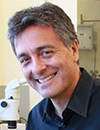08:00 | Conference Registration, Materials Pick-Up, Morning Coffee and Pastries |
|
Session Title: Multi-Cellular Engineered Living Systems Summit |
| |
08:30 |  | Conference Chair Conference Chairperson's Welcome, Introduction and Topics Addressed
Roger Kamm, Cecil and Ida Green Distinguished Professor of Biological and Mechanical Engineering, Massachusetts Institute of Technology (MIT), United States of America
|
|
08:45 |  | Keynote Presentation Engineering Mucosal Barriers: From Organoids to Organs–on–Chips
Linda Griffith, Professor, Massachusetts Institute of Technology (MIT), United States of America
Mucosal barriers are the gateways to all internal organs, serving to transport oxygen, nutrients, and waste and at the same time performing enormous feats of protection against infection and other hazardous insults. The explosion of interest in the human microbiome – especially but not only that in the gut – has driven new interest in building human mucosal barrier models. This talk will highlight three related themes: (i) engineering synthetic microenvironments to expand primary adult epithelial organoids and induce morphogenesis into mucosal barriers (ii) engineering microfluidic devices to create microbial-mucosal interfaces that enable chronic co-culture of the most super strict anaerobes such as Faecalibacterium prausnitzii with a colon mucosal barrier and (iii) interconnection of mucosal barriers with other tissues in systemic circuits to illuminate the role of gut-derived bacterial metabolites on function of other organ systems. Examples will emphasize how these approaches can be used to model chronic inflammatory diseases. |
|
09:30 |  | Keynote Presentation Tissue Organoids For Disease Modeling
Shay Soker, Professor of Regenerative Medicine and Chief Science Program Officer, Wake Forest Institute for Regenerative Medicine, United States of America
Traditional in vitro two dimensional (2D) cell cultures fail to
recapitulate the microenvironment of in vivo tissues. They have three
major differences from native tissue microenvironments: substrate
topography, substrate stiffness, and most importantly, a 2D rather than
three dimensional (3D) architecture. In contrast, 3D human tissue
organoids replicate native tissue structure and function and thus are
superior to traditional 2D cultures and animal models. These organoids
can be studied in vitro for several weeks to allow intensive
investigations. Besides their advantages in drug toxicity testing and
for development of new drugs, the human tissue organoid platform serves
as a model system to explore human tissue development and disease. Our
recent research was focused on the use of human tissue organoids to
study liver development and congenital diseases as well as other common
diseases such as tissue fibrosis and cancer. Altogether our human tissue
organoids system can be used for modeling of a wide verity of diseases
and develop new personalized/precision medicine applications. |
|
10:15 | Morning Coffee Break and Networking |
11:00 |  | Keynote Presentation Parkinson’s-On-a-Chip: Unravelling the Complexity of Neurodegenerative Diseases Using a Chip-based Midbrain Organoid Model
Peter Ertl, Professor of Lab-on-a-Chip Systems, Vienna University of Technology, Austria
One of the main limitations in neuroscience and in the modeling and understanding of neurodegenerative diseases is the lack of advanced experimental in vitro models that truly mimic the complexity of the human brain. With its ability to emulate microarchitectures and functional characteristics of native organs in vitro, induced pluripotent stem cell technology has enabled the generation of human midbrain organoids. To improve organoid reproducibility and iPSC differentiation, we have developed a sensor-integrated organ-on-a-chip platform allowing long-term cultivation and non-invasive monitoring of hMOs under an interstitial flow regime. Our results show that dynamic cultivation of iPSC-derived hMOs maintains high cellular viabilities and dopaminergic neuron differentiation over prolonged cultivation periods of up to 50 days, while neurotransmitter release of hMOs is detected using an electrochemical sensor array. |
|
11:45 |  | Keynote Presentation Body on a Chip: Human Microscale Models for Drug Development
James Hickman, Professor, Nanoscience Technology, Chemistry, Biomolecular Science and Electrical Engineering, University of Central Florida; Chief Scientist, Hesperos, United States of America
The preclinical drug development process is inefficient at selecting drug candidates for human clinical trials, since only 11% of drug candidates selected for clinical trials exit with regulatory approval. Current technology is based on isolated human cells and animal surrogates. We believe that a “human” multiorgan model based on physiologically based pharmacokinetics-pharmacodynamic (PBPK-PD) models that house interconnected modules with tissue mimics of various organs. The system captures key aspects of human physiology that would potentially reduce drug attrition in clinical trials and decrease the cost of development. Integrated, multi-organ microphysiological systems (MPS) based on human tissues (also known as “body-on-a-chip”) could be important tools to improve the selection of drug candidates exiting preclinical trials for those drug most likely to earn regulatory approval from clinical trials. This methodology integrates microsystems fabrication technology and surface modifications with protein and cellular components, for initiating and maintaining self-assembly and growth into biologically, mechanically and electronically interactive functional multi-component systems.
I will describe such systems being constructed at Hesperos and at UCF that are guided in their design by a PBPK model. They are “self-contained” in that they can operate independently and do not require external pumps as is the case with man other microphysiological systems. They are “low cost”, in part, because of the simplicity and reliability of operation. They maintain a ratio of fluid (blood surrogate) to cells that is more physiologic than in many other in vitro systems allowing the observation of the effects of not only drugs but their metabolites. While systems can be sampled to measure the concentrations of drugs, metabolites, or biomarkers, they also can be interrogated in situ for functional responses such as electrical activity, force generation, or integrity of barrier function. Operation up to 28 days has been achieved allowing observation of both acute and chronic responses with serum free media. We have worked with various combinations of internal organ modules (liver, fat, neuromuscular junction, skeletal muscle, cardiac, bone marrow, blood vessels and brain) and barrier tissues (eg skin, GI tract, blood brain barrier, lung, and kidney). The use of microelectrode arrays to monitor electrically active tissues (cardiac and neuronal) and micro cantilevers (muscle) have been demonstrated. Most importantly these technical advances allow prediction of both a drug’s potential efficacy and toxicity (side-effects) in pre-clinical studies. This talk will also give results of six workshops held at NIH to explore what is needed for validation and qualification of these new systems. |
|
12:30 | Networking Lunch and Round-Table Discussions |
|
Session Title: Organoids and 3D-Culture - Technologies and Applications |
| |
|
Session Chair: Dr. Terry Riss, Promega Corporation |
| |
14:00 | Recreating Kidney Organogenesis in vitro with Human Pluripotent Stem Cells
Ryuji Morizane, Assistant Professor, Harvard Medical School; Visiting Scholar, Wyss Institute, United States of America
We have developed an efficient, chemically defined protocol for
differentiating human pluripotent stem cells into multipotent nephron
progenitor cells (NPCs) that can form kidney organoids. By
recapitulating metanephric kidney development in vitro we generate SIX2+SALL1+WT1+PAX2+
NPCs with 80-90% efficiency within 8-9 days of differentiation. NPCs
form kidney organoids containing epithelial nephron-like structures
expressing markers of podocytes, proximal tubules, loops of Henle and
distal nephrons in an organized, continuous arrangement that resembles
the nephron in vivo. The organoids express genes reflecting many
transporters seen in adult metanephric-derived kidney, enabling
assessment of transporter-mediated drug nephrotoxicity. Stromal cells
are also generated with the presence of PDGFRBeta+ fibroblasts/pericytes, and CD31+
endothelial cells. This kidney differentiation system can be used to
study mechanisms of human kidney development. Repetitive injury to
tubular cells causes interstitial fibroblast expansion with
characteristics of myofibroblasts, indicating kidney organoids can be
used to model kidney fibrosis in vitro. Polycystic kidney disease (PKD)
patient-derived organoids exhibit cystic phenotypes. Hence the generated
kidney organoids are effective tools to study genetic disorders of the
kidney as well as mechanisms of kidney injury and fibrosis.
Microphysiological platforms in vitro facilitate kidney organoid
vascularization and maturation, which may lead to the development of
functional bioengineered kidneys in the future. |
14:30 |  | Keynote Presentation Microfluidics For Interrogating Intact Tumor Biopsies
Albert Folch, Professor of Bioengineering, University of Washington, United States of America
The intricate microarchitecture of tissues – the “tissue microenvironment” – is a strong determinant of tissue function. Microfluidics offers an invaluable tool to precisely stimulate, manipulate, and analyze the tissue microenvironment in live tissues and engineer mass transport around and into small tissue volumes. Such control is critical in clinical studies, especially where tissue samples are scarce (e.g. tumor biopsies), in analytical sensors, where testing smaller amounts of analytes results in faster, more portable sensors, and in biological experiments, where accurate control of the cellular microenvironment is needed (e.g. organ-on-a-chip). Microfluidics also provides inexpensive multiplexing strategies to address the pressing need to test large quantities of drugs and reagents on a single biopsy specimen, increasing testing accuracy, relevance, and speed while reducing overall diagnostic cost. I will discuss the development of our platforms for cancer diagnostics that allow for multiplexed functional drug testing on live, intact tissues in various formats: 1) tumor slices; 2) core needle biopsies; and 3) cuboids (precision-sliced tumor fragments that retain viability and the tumor microenvironment for several days). These platforms are currently under commercial development by startup OncoFluidics. |
|
15:00 | Ex Vivo Immuno-Oncology Dynamic Environment For Tumor Biopsies
Jeffrey Borenstein, Group Leader, Synthetic Biology; Director, Biomedical Engineering Center, Draper, United States of America
We present the design, construction and testing of a microfluidic
perfused tumor microenvironment platform capable of evaluating the
efficacy of immune checkpoint inhibitors with circulating immune cells
in mouse and human tumor biopsy fragments. |
15:30 | Afternoo Coffee Break in the Exhibit Hall |
16:15 | Modeling Immune Mediated Beta Cell Destruction in Human Type 1 Diabetes with Organoids
Matthias von Herrath, Vice President and Senior Medical Officer, Novo Nordisk, Professor, La Jolla Institute, United States of America
In the past 15 years we have been studying the pathology of human type 1
diabetes with access to donor pancreata through the human pancreatic
organ donor consortium (nPOD). These studies have led to several
findings, for example that certain cytokines are generated by beta cells
themselves, sometimes under stress, and also that there are probably
key factors that render beta cells susceptible to immune attacks.
Mechanistically, the importance and meaning of these observations needs
to be addressed in a suitable and easily manipulable in vitro system
consisting of human islets and immune cells. We have built such a system
in collaboration with the company InSphero and will discuss emerging
findings. |
16:45 |  | Keynote Presentation Vascular Networks on a Chip and Their Applications
Roger Kamm, Cecil and Ida Green Distinguished Professor of Biological and Mechanical Engineering, Massachusetts Institute of Technology (MIT), United States of America
Due to the capacity of vascular endothelial cells to self-assemble into 3D vascular networks in a conducive hydrogel, it is now possible to grow microvasculature within microfluidic chips comparable to in vivo capillary beds in both morphology and function. These systems have numerous applications including vascularized organs-on-chip, studies of transport across the vascular endothelium, and models of disease. This presentation will focus on the growth of these networks and quantitative analysis of their morphology and transport properties. Results will be discussed showing networks grown from several different sources of endothelial cells that stabilize over 4-7 days, and can then be maintained in some cases for periods of over one month. Various accessory cells are used, including fibroblasts, pericytes and mesenchymal stem cells, and these contribute to changes in matrix composition and mechanics over time. Examples will be used to illustrate some of the potential applications of these vascularized models, selected from metastatic cancer, the blood-brain barrier, and cerebral amyloid angiopathy.
|
|
17:30 | Networking Reception with Beer and Wine in the Exhibit Hall -- Meet Exhibitors and Network with Colleagues |
18:30 | Close of Conference Day |





